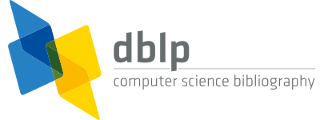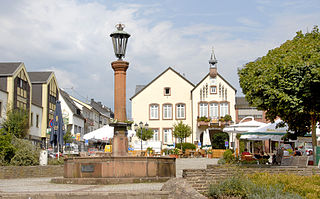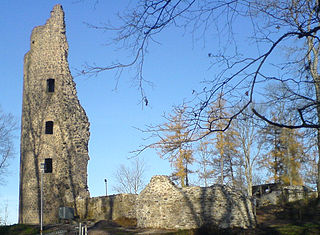
Saarbrücken is the capital and largest city of the state of Saarland, Germany. Saarbrücken has 181,959 inhabitants and is Saarland's administrative, commercial and cultural centre. It is located on the Saar River, directly borders the French department of Moselle, and is Germany's second-westernmost state capital after Düsseldorf.

DBLP is a computer science bibliography website. Starting in 1993 at Universität Trier in Germany, it grew from a small collection of HTML files and became an organization hosting a database and logic programming bibliography site. Since November 2018, DBLP is a branch of Schloss Dagstuhl – Leibniz-Zentrum für Informatik (LZI). DBLP listed more than 5.4 million journal articles, conference papers, and other publications on computer science in December 2020, up from about 14,000 in 1995 and 3.66 million in July 2016. All important journals on computer science are tracked. Proceedings papers of many conferences are also tracked. It is mirrored at three sites across the Internet.
The Max Planck Institute for Informatics is a research institute in computer science with a focus on algorithms and their applications in a broad sense. It hosts fundamental research as well a research for various application domains.

Wadern is a municipality in the federal state Saarland, which is situated in the southwest of Germany. It is part of the district Merzig-Wadern. Wadern consists of 13 urban districts with approximately 16.000 inhabitants. With 143 inhabitants per km2 it is sparsely populated, but, with an area of 111 km2, Wadern is the third largest municipality in Saarland after Saarbrücken and St. Wendel. The town is divided into 14 urban districts and altogether 24 villages belong to the commune. The town is part of the Moselle Franconian language area.

Saarland University is a public research university located in Saarbrücken, the capital of the German state of Saarland. It was founded in 1948 in Homburg in co-operation with France and is organized in six faculties that cover all major fields of science. In 2007, the university was recognized as an excellence center for computer science in Germany.

Mettlach is a municipality in the district Merzig-Wadern, in Saarland, Germany, situated on the river Saar, approximately 7 km (4.3 mi) northwest of Merzig, and 30 km (19 mi) south of Trier. The headquarters of Villeroy & Boch are in Mettlach. Also, the Mettlach tiles are named after the municipality.

Dagstuhl Castle is a ruined castle on the top of a hill near the town of Wadern, kreis Merzig-Wadern, in Saarland, Germany. It overlooks the newer Schloss Dagstuhl in the valley below, which is historic, but has been converted for use as a meeting centre for computer science.
The Symposium on Theoretical Aspects of Computer Science (STACS) is an academic conference in the field of computer science. It is held each year, alternately in Germany and France, since 1984. Typical themes of the conference include algorithms, computational and structural complexity, automata, formal languages and logic.
The European Symposium on Algorithms (ESA) is an international conference covering the field of algorithms. It has been held annually since 1993, typically in early Autumn in a different European location each year. Like most theoretical computer science conferences its contributions are strongly peer-reviewed; the articles appear in proceedings published in Springer Lecture Notes in Computer Science. Acceptance rate of ESA is 24% in 2012 in both Design and Analysis and Engineering and Applications tracks.
WADS, the Algorithms and Data Structures Symposium, is an international academic conference in the field of computer science, focusing on algorithms and data structures. WADS is held every second year, usually in Canada and always in North America. It is held in alternation with its sister conference, the Scandinavian Symposium and Workshops on Algorithm Theory (SWAT), which is usually held in Scandinavia and always in Northern Europe. Historically, the proceedings of both conferences were published by Springer Verlag through their Lecture Notes in Computer Science series. Springer continues to publish WADS proceedings, but starting in 2016, SWAT proceedings are now published by Dagstuhl through their Leibniz International Proceedings in Informatics.
Susanne Boll is a Professor for Media Informatics and Multimedia Systems in the Department of Computing Science at the University of Oldenburg, Germany. and is a member of the board at the research institute OFFIS. She is a member of SIGMM and SIGCHI of the ACM as well as the German Informatics Society GI. She founded and directs the HCI Lab at the University of Oldenburg and OFFIS.
Raimund G. Seidel is a German and Austrian theoretical computer scientist and an expert in computational geometry.

Reinhard Wilhelm is a German computer scientist.
The German Informatics Society (GI) is a German professional society for computer science, with around 20,000 personal and 250 corporate members. It is the biggest organized representation of its kind in the German-speaking world.
RAMiCS, the International Conference on Relational and Algebraic Methods in Computer Science, is an academic conference organized every eighteen months by an international steering committee and held in different locations mainly in Europe, but also in other continents. Like most theoretical computer science conferences, its contributions are strongly peer-reviewed. Proceedings of the conferences appear in Lecture Notes in Computer Science, and some of the stronger papers have been published in Journal of Logical and Algebraic Methods in Programming.
The International Conference on Concurrency Theory (CONCUR) is an academic conference in the field of computer science, with focus on the theory of concurrency and its applications. It is the flagship conference for concurrency theory according to the International Federation for Information Processing Working Group on Concurrency Theory. The conference is organised annually since 1988. Since 2015, papers presented at CONCUR are published in the LIPIcs–Leibniz International Proceedings in Informatics, a "series of high-quality conference proceedings across all fields in informatics established in cooperation with Schloss Dagstuhl –Leibniz Center for Informatics". Before, CONCUR papers were published in the series Lecture Notes in Computer Science.
Multitier programming is a programming paradigm for distributed software, which typically follows a multitier architecture, physically separating different functional aspects of the software into different tiers. Multitier programming allows functionalities that span multiple of such tiers to be developed in a single compilation unit using a single programming language. Without multitier programming, tiers are developed using different languages, e.g., JavaScript for the Web client, PHP for the Web server and SQL for the database. Multitier programming is often integrated into general-purpose languages by extending them with support for distribution.
The International Symposium on Experimental Algorithms (SEA), previously known as Workshop on Experimental Algorithms (WEA), is a computer science conference in the area of algorithm engineering.
Deepak Kapur is a Distinguished Professor in the Department of Computer Science at the University of New Mexico.
AofA, the International Meeting on Probabilistic, Combinatorial and Asymptotic Methods for the Analysis of Algorithms is an academic meeting that has been held regularly since 1993 in the field of computer science, focusing on mathematical methods from analytic combinatorics and probability for the study of properties of algorithms and large combinatorial structures. In early years, different formal names were used, but the meeting and associated community of researchers has always been known as AofA.













